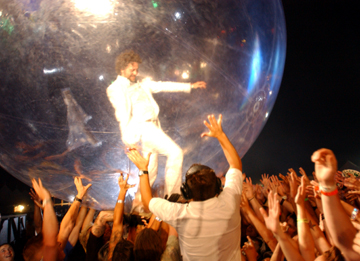 Wayne Coyne becomes a bubble boy to surf the crowd at ‘Coachella.’
Wayne Coyne becomes a bubble boy to surf the crowd at ‘Coachella.’
|
| Coachella\r\nStarring 25 alt-music acts. Directed by Drew Thomas. Rated R. Opens Apr. 7 at AMC Grapevine Mills. |
|
A D V E R T I S E M E N T
|
|
|
|
A D V E R T I S E M E N T
|
|
Indio Rock
Never been to Coachella? The movie gives you the music without the heatstroke.
By KRISTIAN LIN
The concert film is a relatively young genre, but recent examples of it have showcased different approaches to filming a musical performance. Jonathan Demme went ragged and stripped-down for Neil Young: Heart of Gold. Michel Gondry plunged into the unfamiliar world of hip-hop with an academic’s curiosity in Dave Chappelle’s Block Party. Adam Yauch handed 50 cameras over to the Beastie Boys’ fans and let their collective imagination run riot in Awesome; I Fuckin’ Shot That!
Drew Thomas exhibits no such innovation in his first filmmaking effort Coachella, a documentary consisting of footage from six years’ worth of performances from the Coachella Valley Music & Arts Festival. The event takes place in a polo field in Indio, Calif., in the middle of the Sonoran Desert. The movie gives us little sense of the atmosphere. We get a few shots of the mountains in the distance, but we come away with no idea of what the city and its surroundings actually look like or even how notoriously hot the temperature can be during the day. (Indeed, most of the movie’s footage is of nighttime performances. One of the few daytime shots is of The Polyphonic Spree performing, appopriately enough, “It’s the Sun.”) The movie’s such an unabashed valentine to the festival that it glosses over its negative aspects. When we see Wayne Coyne of The Flaming Lips surfing the crowd in a giant transparent plastic bubble, it looks pretty cool. You’d never guess that the stunt might have endangered audience members below. That’s because the movie never tells you about complaints posted on the internet about the bubble, and about the extortionate prices charged in past years for drinking water, no small consideration in a desert environment.
The movie also doesn’t really tell you what makes Coachella different from other festivals. One of the few clues is found in the shots of the giant-sized artworks that share lawn space with the festivalgoers, who camp out for the event’s duration. Christian Ristow’s fire-breathing robots are intercut effectively with Prodigy’s performance of “Their Law.” There aren’t enough details like these, though. The conversations with fans all exude the same crunchy Left Coast “We dig music” attitude — did nobody have anything more interesting to say? The same mostly goes for the interviews with the musicians, although there is an interesting bit where the filmmakers juxtapose Saul Williams arguing that music can change the world with Oasis’ Noel Gallagher stating that it can’t.
Still, fans who go to these festivals are willing to endure hardships and go without creature comforts for the music. They’ll surely be willing to endure the pedestrian filmmaking to see the all-star lineup of musical acts. Belle & Sebastian inject a note of sophistication into the proceedings early, with frontman Stuart Murdoch musing about the weather and ad-libbing lyrics to “The Boy With the Arab Strap”: “What do you think of the sound of The Foo Fighters / Floating across the polo pitch on a summer’s day? / Well, it’s not quite summer, but it seems like summer to us.” The White Stripes contribute a raffish version of “Hotel Yorba,” immediately followed by Iggy & The Stooges rocking “I Wanna Be Your Dog” like it’s still 1975. (This, even though Iggy Pop “looks like a chewed-up piece of wire,” according to his adoring fan, Josh Homme of Queens of the Stone Age.) Meanwhile, Björk is her usual Björky self in a rapturous rendition of “All Is Full of Love.”
It isn’t all good. Nu Mark and Cut Chemist’s table-turning collaboration is a little too precious — it reminded me of those old tv variety shows that featured guys playing banjos with their feet. It must have been awesome to be there for the 2004 reunion of The Pixies, but their performances of “In Heaven” and “Where Is My Mind?” don’t set the screen afire. The laser light show going on behind Radiohead overwhelms the song that they’re playing, even though said song (“Planet Telex”) is pretty good. The lowlight here is probably Conor Oberst’s “Lua,” the sparse arrangement only underlining the song’s callowness.
Even with all that, there are still enough musical gems to make the film worth a look for alt-rock fans. It isn’t clear, though, why the years of Coachella performances couldn’t have been documented in a compilation c.d. instead of a movie. There just aren’t enough points of interest here to draw in a casual moviegoer. A great concert film gives you the sense of having been there. Coachella even at its best only gives the sense of “I guess you had to be there.”
 Email this Article...
Email this Article...

